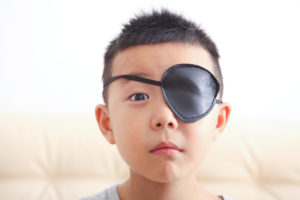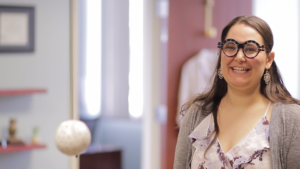Wow Vision Therapy Blog
Effective Amblyopia Treatment Requires Binocular Vision Rehabilitation

Amblyopia/Lazy eye is a severe neurodevelopmental vision problem that causes vision loss in approximately 2-4% of the population or 1 in 30 people. Neuroscience shows that Amblyopia occurs when there is a unilateral failure in binocular vision, occurring early in life – typically infancy or toddlerhood.
When the binocular system is broken at a young age, a neuroadaptation occurs, known as suppression, where the signal from one eye is “shut down” by the brain to counteract the confusion created by the broken binocular system. As a result of this unilateral failure of binocular function, a cascade of delayed visual function occurs leading to the following:
- Reduced visual acuity (eyesight) in one eye
- Reduced, or no stereo acuity (depth perception)
- Poor saccadic eye movement
- Poor visual processing ability
- Poor eye-hand coordination
Thus, due to a failure in binocular vision, a spiral of visual problems occurs that is much more involved than visual acuity of one eye. But, because visual acuity is reduced in one eye even with the best correction, Amblyopia is one condition in optometry and ophthalmology that should never be misdiagnosed or overlooked.
 Indeed, even though patching for Amblyopia has been around for 300 years, it still is touted on many notable sources to be the treatment of choice for Amblyopia. In fact, patching the non-amblyopic eye, either part-time or full-time, is evidence-based and outlined in various PEDIG Amblyopia Treatment Study (ATS) research clinical trials. These ATS clinical trials have shown a moderate amount of improvements in the visual acuity function of the amblyopic eye with occlusion therapy. However, what the PEDIG ATS research doesn’t show is that patching has a multitude of negative side-effects that are outlined in several other research papers. Also, visual acuity gains often regress when the treatment ends, plus, and even more critical, patching does not repair the broken binocular visual system, which is the underlying cause for the patient’s Amblyopia.
Indeed, even though patching for Amblyopia has been around for 300 years, it still is touted on many notable sources to be the treatment of choice for Amblyopia. In fact, patching the non-amblyopic eye, either part-time or full-time, is evidence-based and outlined in various PEDIG Amblyopia Treatment Study (ATS) research clinical trials. These ATS clinical trials have shown a moderate amount of improvements in the visual acuity function of the amblyopic eye with occlusion therapy. However, what the PEDIG ATS research doesn’t show is that patching has a multitude of negative side-effects that are outlined in several other research papers. Also, visual acuity gains often regress when the treatment ends, plus, and even more critical, patching does not repair the broken binocular visual system, which is the underlying cause for the patient’s Amblyopia.
It should seem fairly obvious that you can not repair a broken binocular system by patching an eye. Patching only re-enforces the failure of binocular vision. Therefore, 3-D, depth perception (i.e., stereo acuity, which is a measure of the quality of binocular vision), is ignored when a patient is sent home to wear an eye patch. Therefore, using an occlusion-based model of treatment, stereo acuity does not develop nor do the related other conditions involving poor micro eye movement, poor visual processing, and poor eye-hand coordination.
Professionals and patients need to understand that the loss of monocular eyesight in Amblyopia is due to a broken binocular system. Due to this failure in binocular vision, effective treatment must include the vision rehabilitation of visual processing, oculomotor/saccadic eye movement, eye-hand coordination that begins with vision rehabilitation of the binocular visual system. The progress in vision rehabilitation should be measured not just based on visual acuity, but also stereo acuity and specific tests of visual processing and eye-hand coordination.
 Furthermore, research shows that effective developmental vision rehabilitation must be office-based with home support that is carefully monitored and altered as needed to get consistent compliance and results. Prescribed treatment should be 45-60 minutes office-based vision therapy, 1-2 times per week, with 1 hour per day of home activities that require close support by the supervising doctor and/or vision therapist.
Furthermore, research shows that effective developmental vision rehabilitation must be office-based with home support that is carefully monitored and altered as needed to get consistent compliance and results. Prescribed treatment should be 45-60 minutes office-based vision therapy, 1-2 times per week, with 1 hour per day of home activities that require close support by the supervising doctor and/or vision therapist.
Only when the complexity of Amblyopia is addressed with a comprehensive developmental vision rehabilitation delivery of care model, will patients have the chance to have successful outcomes in their Amblyopia treatment. We must begin to realize that the best care for patients with Amblyopia goes beyond patching.
Dan L. Fortenbacher, O.D., FCOVD
GET IN TOUCH
To learn more, please fill out the form below and one of our Patient Care Coordinators will be in touch to answer your questions or help schedule an evaluation for you.
